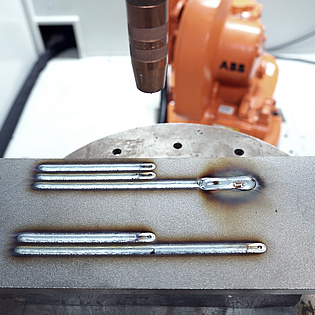3D Welding. Optimised Components from the “Metal Printer”
Since January 2020 the team from the Institute for Structural Design, including Christoph Holzinger, Stefan Peters, Jana Rieth and Andreas Trummer, have been working on the Collective Research Project "3D Welding: Additive Fabrication of Structural Steel Elements" to investigate the possibilities regarding 3D printed metals within the field of construction.
Under the project management of the Fachverband Metalltechnische Industrie [Metaltechnology Austria] (FMTI) and in cooperation with the Laboratory for Structural Engineering (represented by Bernhard Freytag) and the Institute for Materials Science, Joining and Forming (represented by Norbert Enzinger), the extent to which the additive production of metal components can be used in structural steel construction is being investigated. The technology enables both the production of regular forms such as simple structural reinforcements and the production of topology-optimised free-forms, considering load-bearing capacity and serviceability. In practice, the steel printing process may also be used in the production of filigree components such as lattice shell nodes for glass facades.
In the additive manufacturing process, the robot puts layers of welding seams one over another. In contrast to the subtractive process still widely used in steel construction, in which material is removed by milling or drilling, the innovative advantage of steel printing is its almost one hundred percent material efficiency. According to Christoph Holzinger, this is a factor that not only conserves resources, but can also help to reduce costs. The first major challenge that the research team faced at the start of the project concerns the factor of time, since necessary cooling times must be considered for printing tests. The aim is to find printing strategies that minimise downtime, while maximising deposition rates. By December 2021, the process will have been researched and developed to such an extent that it can be established in practice and recommendations for construction industry standards can be made. Until then, students have the opportunity to write their diploma theses at the Institute for Structural Design focussing on this topic.


